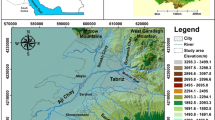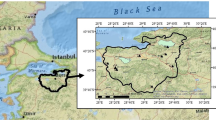Abstract
The Tabriz area is a densely populated area of northwestern Iran (more than 1.5 million in population) with a large proportion of its drinking, domestic, industrial and agricultural water supplied from groundwater resources. The average rate of drinking and industrial water use in the city of Tabriz is about 3.45 m3 s–1. The Plio-Pleistocene unconfined alluvial tuff aquifer (about 1,275 km2), the most important aquifer in the area, has been known for many years as a reliable resource. The greatest estimated thickness of the alluvial tuff lies in the Saidabad area, with 350 m thickness. There are 994 deep and 284 shallow active pumping wells and 83 qanats operate in the alluvial tuff aquifer. The total water withdrawal from all these artificial discharge points has been measured at 72, 3.8 and 17 million m3/year, respectively. Analytical and numerical methods have been applied to the constant rate pumping test data from the Saidabad wellfield (eight pumping and three observation wells). The values of electrical conductivity in the groundwater of alluvial tuff aquifer range from 203 to 960 μS cm–1 and bicarbonate type water dominates.
Résumé
Le secteur de Tabriz est une région à forte densité de population au Nord-Ouest de l'Iran (population supérieure à 1.5 million d'habitants), où les ressources en eau souterraine fournissent une grande partie de l'eau potable et à usage domestique, industriel et agricole. Les besoins moyens en eau potable et industrielle de la ville de Tabriz s’élèvent à 3.45 m3s-1 environ. L’aquifère libre des tuffs alluvionnaires plio-pléistocènes (environ 1,275 km2), le plus important du secteur, est considéré depuis longtemps comme une ressource fiable. La puissance maximale estimée des tuffs alluvionnaires est de 350 m, dans la région de Saidabad. Au total 994 puits profonds et 284 puits peu profonds en activité, ainsi que 83 qanats, exploitent l’aquifère des tuffs alluvionnaires. Les prélèvements en eau totaux pour toutes ces émergences artificielles ont été estimés respectivement à 72, 3.8 et 17 millions m3 par an. Des méthodes analytiques et numériques ont été appliquées aux données du pompage d’essai à débit constant du champ de captage de Saidabad (huits puits de pompage et trois piézomètres). Les valeurs de conductivité électrique de l’eau de l’aquifère des tuffs alluvionnaires sont comprises entre 203 et 960 μScm–1, et les faciès bicarbonatés prédominent.
Resumen
La región de Tabriz constituye un área densamente poblada del noroeste de Irán (más de 1.5 millones de personas) con un gran porcentaje de agua para uso doméstico, industrial y agrícola abastecido de recursos de agua subterránea. El ritmo promedio de uso de agua industrial y para consumo humano en la ciudad de Tabriz es aproximadamente 3.45 m3s–1. El acuífero de toba aluvial no confinado de edad Plio-Pleistoceno (que cubre un área de aproximadamente 1,275 km2), el acuífero más importante del área, ha sido bien conocido por muchos años como un recurso confiable. El mayor espesor estimado de la toba aluvial se encuentra en el área Saidabad, con 350 m de espesor. Existen 994 pozos de bombeo activos profundos y 284 pozos someros y 83 qanats funcionando en el acuífero de toba aluvial. La explotación total de agua en estos puntos artificiales de descarga se ha estimado en 72, 3.8, y 17 millones m3 por año, respectivamente. Se han aplicado métodos numéricos y analíticos a datos provenientes de pruebas de bombeo constantes del campo de pozos Saidabad (ocho pozos de bombeo y tres pozos de observación). Los valores de conductividad eléctrica en el agua subterránea de la toba aluvial varían de 203 a 960 μS cm–1 con aguas dominantes del tipo bicarbonato.









Similar content being viewed by others
References
Asghari Moghaddam A (1991) The hydrogeology of the Tabriz area, Iran. PhD Thesis. University College London, London
Azarbaijan Regional Water Authority (2003) Detailed data collection from discharges of pumping wells and qanats in the northern part of the Sahand Mountain slopes [in Persian]. Azarbaijan Regional Water Authority, Tabriz
Bayati Khatibi M (2004) Research on homogeneity changes analysis of Sahand Mountain valleys [in Persian]. University of Tabriz, Tabriz
Clesceri LS, Greenberg AE, Trussel RR (1989) Standard methods for the examination of water and wastewater, 17th edn. American Public Health Association, Washington, DC
Cooper HH, Jacob CE (1964) A generalized graphical method for evaluating formation constants and summarizing well field history, vol 27. Trans Amer Geophys Union, AGU, Washington, DC, pp 526–534
Freeze RA, Cherry JA (1979) Groundwater. Prentice Hall, Englewood Cliffs, NJ, p 604
Hounslow AW (1995) Water quality data analysis and interpretation. Lewis, New York, p 397
Islamic Republic of Iran, Planning and Budget Organization (2002) Iran statistical yearbook. Statistical Center of Iran, Tehran
Jones GP, Rushton KR (1981) Pumping test analysis. Clarendon, Oxford, pp 65–86
Rushton KR (1978) Estimating transmissivity and storage coefficient from abstraction well data. In: Groundwater, vol 16. No. 2, pp 81–85
Rushton KR (2003) Groundwater hydrology, conceptual and computational models. Wiley, Chichester, p 416
Rushton KR, Booth SJ (1976) Pumping test analysis using a discrete time-discrete space numerical method. J Hydrol 28:13–27
Rushton KR, Chan YK (1976) A numerical model for pumping test analysis. Proc. Institute of Civil Engineers, part 2, ICE, London, pp 281–296
Rushton KR, Rathod KS (1988) Causes of non-linear step pumping test responses. Q J Eng Geol 21:147–158
Rushton KR, Redshaw SC (1979) Seepage and groundwater flow. Wiley, Chichester, p 332
Rushton KR, Srivastava NK (1988) Interpreting injection well tests in an alluvial aquifer. J Hydrol 28:49–60
Singhal BBS, Gupta RP (1999) Applied hydrogeology of fractured rocks. Kluwer, Dordrecht, p 258
Theis CV (1935) The relation between the lowering of the piezometric surface and the rate and duration of discharge of the well using groundwater storage, vol 22. Trans Amer Geophys Union, AGU, Washington, DC, pp 519–524
Zolfegari H (2000) Analysis of temporal and spatial patterns of daily rainfall in the west of Iran using statistical and synoptic approaches (in Persian). PhD Thesis, University of Tabriz, Tabriz, Iran
Acknowledgements
The authors wish to acknowledge the Azarbaijan Regional Water Authority for supplying the existing relevant data. We would like to thank A. Alinazhad and A. Mohammadi for their kind help during the field visits and the collection of data.
Author information
Authors and Affiliations
Corresponding author
Rights and permissions
About this article
Cite this article
Asghari Moghaddam, A., Allaf Najib, M. Hydrogeologic characteristics of the alluvial tuff aquifer of northern Sahand Mountain slopes, Tabriz, Iran. Hydrogeol J 14, 1319–1329 (2006). https://doi.org/10.1007/s10040-006-0036-1
Received:
Accepted:
Published:
Issue Date:
DOI: https://doi.org/10.1007/s10040-006-0036-1




